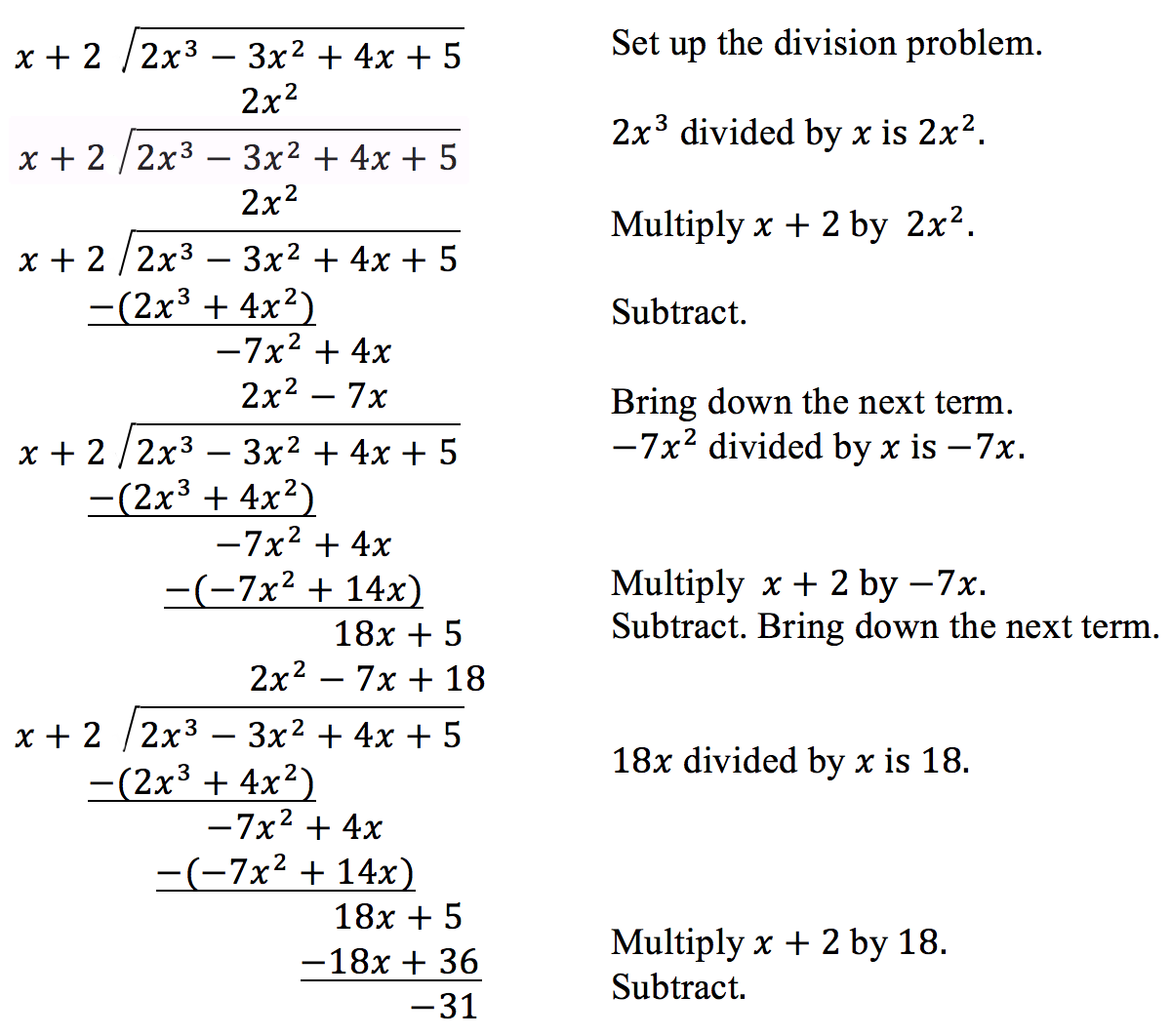Learning Outcomes
- Divide polynomials by binomials using synthetic division or long division
- Identify horizontal asymptotes
In the Limits at Infinity and Asymptotes section, skills needed include polynomial long division and finding horizontal asymptotes. These two topics will be reviewed here.
Perform Polynomial Long Division
Division of polynomials that contain more than one term has similarities to long division of whole numbers. We can write a polynomial dividend as the product of the divisor and the quotient added to the remainder. The terms of the polynomial division correspond to the digits (and place values) of the whole number division. This method allows us to divide two polynomials. For example, if we were to divide [latex]2{x}^{3}-3{x}^{2}+4x+5[/latex] by [latex]x+2[/latex] using the long division algorithm, it would look like this:

We have found
[latex]\frac{2{x}^{3}-3{x}^{2}+4x+5}{x+2}=2{x}^{2}-7x+18-\frac{31}{x+2}[/latex]
or
[latex]2{x}^{3}-3{x}^{2}+4x+5=\left(x+2\right)\left(2{x}^{2}-7x+18\right)-31[/latex]
How To: Given a polynomial and a binomial, use long division to divide the polynomial by the binomial
- Set up the division problem.
- Determine the first term of the quotient by dividing the leading term of the dividend by the leading term of the divisor.
- Multiply the answer by the divisor and write it below the like terms of the dividend.
- Subtract the bottom binomial from the terms above it.
- Bring down the next term of the dividend.
- Repeat steps 2–5 until reaching the last term of the dividend.
- If the remainder is non-zero, express as a fraction using the divisor as the denominator.
Example: Using Long Division to Divide a Second-Degree Polynomial
Divide [latex]5{x}^{2}+3x - 2[/latex] by [latex]x+1[/latex].
Example: Using Long Division to Divide a Third-Degree Polynomial
Divide [latex]6{x}^{3}+11{x}^{2}-31x+15[/latex] by [latex]3x - 2[/latex].
Try It
Find Horizontal Asymptotes
Horizontal asymptotes help describe the behavior of a graph as the input gets very large or very small. Recall that a polynomial’s end behavior will mirror that of the leading term. Likewise, a rational function’s end behavior will mirror that of the ratio of the leading terms of the numerator and denominator.
A General Note: Horizontal Asymptotes of Rational Functions
The horizontal asymptote of a rational function can be determined by looking at the degrees of the numerator and denominator.
- Case 1: Degree of numerator is less than degree of denominator: horizontal asymptote at [latex]y=0[/latex]
- Case 2: Degree of numerator is greater than degree of denominator by one: no horizontal asymptote; slant asymptote.
- If the degree of the numerator is greater than the degree of the denominator by more than one, the end behavior of the function’s graph will mimic that of the graph of the reduced ratio of leading terms.
- Case 3: Degree of numerator is equal to degree of denominator: horizontal asymptote at ratio of leading coefficients.
Example: Identifying Horizontal and Slant Asymptotes
For the functions below, identify the horizontal or slant asymptote.
- [latex]g\left(x\right)=\dfrac{6{x}^{3}-10x}{2{x}^{3}+5{x}^{2}}[/latex]
- [latex]h\left(x\right)=\dfrac{{x}^{2}-4x+1}{x+2}[/latex]
- [latex]k\left(x\right)=\dfrac{{x}^{2}+4x}{{x}^{3}-8}[/latex]
Try It
Watch this video to see more worked examples of determining which kind of horizontal asymptote a rational function will have.
 The quotient is [latex]5x - 2[/latex]. The remainder is 0. We write the result as
The quotient is [latex]5x - 2[/latex]. The remainder is 0. We write the result as
